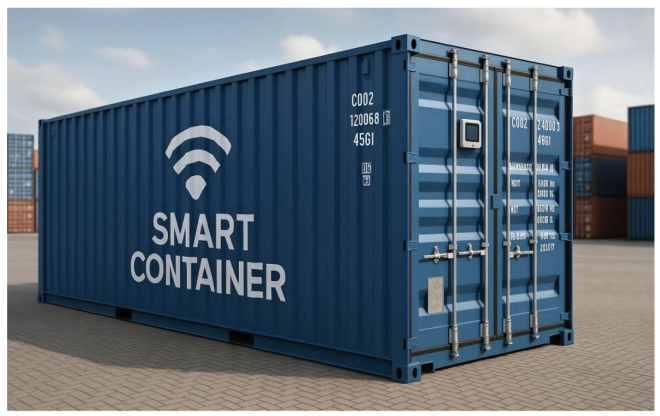- Change theme
Smart Containers—The Future of Efficient and Secure Cargo Transport

Let’s take a closer look at how smart containers actually work and the specific advantages they bring to the world of cargo transport.
02:36 03 May 2025
Imagine a container that tells you its exact location in real time, monitors the condition of the goods inside, and even predicts its arrival down to the minute. This isn’t science fiction—it’s the reality of modern logistics. Smart containers equipped with IoT sensors and GPS tracking systems are opening up a world of new possibilities. Read on to learn more.
Let’s take a closer look at how smart containers actually work and the specific advantages they bring to the world of cargo transport.
What Are Smart Containers and How Do They Work?
Smart containers represent a major leap forward in shipping and logistics. These are standard transport containers enhanced with advanced IoT sensors that continuously monitor and transmit data on location, temperature, humidity, and other key parameters. Equipped with their own power supply, these devices enable uninterrupted data transmission to cloud platforms, allowing for real-time information processing.
The functionality of smart containers goes far beyond simple monitoring—they offer a comprehensive overview of the container’s journey, including precise GPS tracking, environmental condition analysis, and alerts in case of tampering. Thanks to intuitive applications, stakeholders can make informed decisions based on real-time data, such as estimated arrival times or warnings when the container deviates from planned routes.
Key Benefits of Smart Containers in Modern Logistics
Smart container technology brings a range of advantages that are transforming the logistics sector. Accurate prediction of arrival times allows all stakeholders—from customers to port operators—to eliminate bottlenecks and streamline the entire process. Real-time updates on location and cargo condition also enable a proactive approach to mitigating risks of damage or delays.
Smart containers significantly reduce costs associated with port and terminal downtime. Data collected from the containers improves overall fleet management, optimizes routes, and minimizes the movement of empty containers, resulting in major financial savings and a reduced carbon footprint on a global scale.
For temperature-sensitive goods such as food or pharmaceutical products, IoT sensors in smart containers are nothing short of revolutionary—they ensure that conditions inside the container remain optimal throughout the entire journey. In addition, security features like unauthorized access detection significantly reduce the risk of theft and support efforts to combat illegal trade.
Types and Practical Uses of Smart Containers
Smart containers are generally divided into two main categories based on how the technology is implemented:
- Smart containers with externally attached devices, which are temporarily installed on the container and can be transferred to another unit after use.
- Integrated smart containers with built-in technologies, where tracking and monitoring features are embedded directly into the container structure, making them “smart by default” with no need for additional installation.
These technological marvels have a wide range of real-world applications, including:
- monitoring temperature-sensitive goods such as pharmaceuticals or food,
- tracking routes for high-value cargo to enhance security,
- optimizing fleet use and reducing empty container transport,
- usingpredictive analysisof arrival times for more efficient planning,
- automating customs processes with reliable data on cargo movement.
The Future of Logistics with Smart Container Technology
The adoption of smart containers is rapidly accelerating on a global scale, opening new horizons across the entire logistics ecosystem. According to expert forecasts, this will be one of the most significant transformational factors in cargo transport over the next decade.
Integration with Other Technologies
The future of smart containers doesn’t lie in isolated use but in their connection with other advanced technologies. For example, blockchain systems can provide tamper-proof documentation of a container’s journey, while artificial intelligence can analyze movement and condition data to generate predictive models. These synergies multiply the potential of each individual technology.
The Future Lies in Standardization
Despite their clear advantages, the widespread adoption of smart containers faces several challenges. The initial investment in smart container technology remains significant, although decreasing prices of sensors and communication modules are gradually reducing this barrier. Data format and protocol standardization remain another key challenge—without a common “language,” different systems cannot communicate effectively across the supply chain.
Environmental Impact
In an era of increasing focus on sustainability, smart containers offer significant environmental benefits. Route and load optimization reduces unnecessary movement of empty containers, leading to a substantial decrease in carbon emissions. Additionally, precise monitoring of conditions inside the container minimizes the risk of spoilage, helping to reduce waste and conserve resources.
Summary
Smart containers are not just another tech trend—they represent a fundamental transformation of the global logistics ecosystem. For companies that aim not just to survive but to thrive in the logistics sector, the question is not if but when to implement these revolutionary technologies into their operations.
Used sources:
